






Yorkshire, England 2015 - Bolton Castle & Wensleydale
return to Yorkshire trip index
return to mdimage site index
We drove on the usual narrow roads from Thirsk to get to really narrow & curvy roads, as we ascended into the Yorkshire Dales, heading to Wensleydale, a beautiful sheep-grazing area.
Our first destination was Bolton Castle, but we stopped partway there in sleepy Bedale, for coffee or tea. We stopped again at Redmire to get our bearings & a photo of a large Maple tree.
note - you can enlarge any part of a picture by left-clicking in and then out again.
 |
Bedale |
 |
Redmire |
 |
|
 |
big friendly male cat |
 |
Inns are everywhere | ||
 |
roadside views in lower Wensleydale |
 |
Bolton Castle & the Scrope family -
In the 1300s, Feudal custom prohibited English Barons from building their own fortifications. You could have a manor house, but not a castle, the architectural difference being crenellations, or battlement towers. Should you presume to crenellate your manor without Royal permission, your entire property could be confiscated by the King's men, or worse.
As early as the 1200s, Scrope family members came into prominence for dedicated service to successive Kings of England, and, were granted a lot of land in 'Wensley'. In 1333, Sir Henry Scope was appointed Chief Baron of the Exchequer, under Edward III.
In 1364 Sir Henry's third son Richard Scrope became a loyal & distinguished Knight, engaged in many skirmishes on the Continent, and in Palestine, as part of a Crusade. Sir Richard became an important economic advisor to the King and fourteen years later (1378) he was appointed Lord Chancellor of England.
A year later, perhaps 'feeling his oats', Sir Richard petitioned the King & was granted a License to Crenellate at Bolton Manor, and twenty years later, in 1399, Bolton Castle was occupied. The family tradition of service to the Crown continued when Sir Richard's eldest son William was knighted, and in 1398 was appointed Treasurer of England, under Richard II.
The Castle - the official guide states that Bolton Castle is "one of the best preserved examples of a medieval fortress in private ownership in England today". It also states that it is was "an extravagantly luxurious dwelling....and a bold expression of the Scrope family's status, power and royal approval."
The Castle walls were built with innovative vertical air shafts to vent smoke up & away from kitchen cooking fires, thereby preventing the age-old problem in castles all over Europe, whereby royals and servants (or other residents) in upstairs apartments were constantly subject to kitchen smoke.
In 1568, Mary Stuart, Queen of Scotland, a powerful relative of Queen Elizabeth I, with a legitimate claim to the English throne, had to flee to England for her own safety, due to treacherous & conniving Scottish Lords back home.
As soon as Mary entered England, she became an existential threat to Queen Elizabeth I, who was determined to prevent MQoS from leading a Catholic uprising. Elizabeth I initially placed Mary under house arrest at Bolton Castle for 6 months, the first of Mary's 18 years of confinement.
Mary had it good here, treated as royalty. She & her entourage took over the Castle. Lord Scrope's wife, a fellow Catholic, was very accommodating and they came to enjoy each other's daily company.
Lady Scrope was the day-to-day ruler of this small kingdom, for Lord Scrope was assigned to a defensive military unit, at Carlisle Castle, 150 miles away, keeping an eye on the English-Scottish Border.
Mary and her mates were allowed to wander the surrounding Dales, riding horses & hunting. She somehow managed to get caught conspiring with local Catholics, or Papists, and this got her & the locals into trouble. She was ordered by Elizabeth I to move to a less luxurious place, and, her conditions of captivity gradually worsened over her remaining years.
All info on this page comes from the official Bolton Castle brochure, or, from the popular recent book Queen of Scots, 2004, by John Guy.
 |
Bolton Castle |
 |
granary & kitchen |
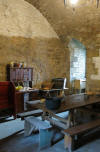 |
|
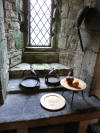 |
 |
< vineyard & maze and Chapel > |
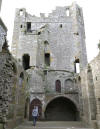 |
||
 |
 |

|
 |
||
 |
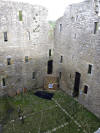 |
multi-storied |
 |
||
 |
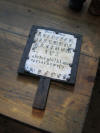 |
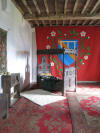 |
Mary Queen of Scots' bedroom | ||
 |
 |
 |
|||
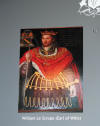 |
the Lords Scrope |
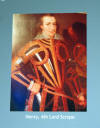 |
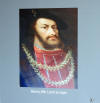 |
||
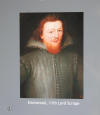 |
 |
great view from the top |
 |
||
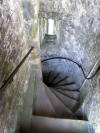 |
favoring right-handed defenders |
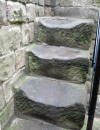 |
see note |
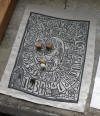 |
Bolton Castle is a fine structure, five floors high & fun to explore, in a great setting, and we had the place to ourselves. There was also a nice coffee/tea shop.
Afterwards, our drive up into Wensleydale continued & we almost made it to Hawes, near the upper part of the valley, where the Yorkshire Dales National Park Visitor Center is, and, where globally appreciated Wensleydale cheeses are made.
Instead, we drove up roads opposite Hawes, near the tiny village of Burtersett, in search of an old Roman road, shown on the OS map as Cam High Road, which had a steady uphill grade in enjoyable Dales scenery.
 |
Bainbridge |
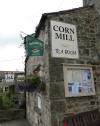 |
lunch stop |
 |
a relaxed Dales town |
 |
 |
stone barns near Bainbridge | |||
 |
Hawes |
 |
 |
Wether Fell | |
 |
upper Wensleydale |
 |
walking on a Roman road |
The drive from Kilburn Park into Wensleydale was amazing. We took a different road back and drove through Leyburn, in a beautiful landscape.
This was the longest drive of the trip & night fell before we were home.
go to next page - Castle Howard
return to Yorkshire trip index
return to mdimage site index